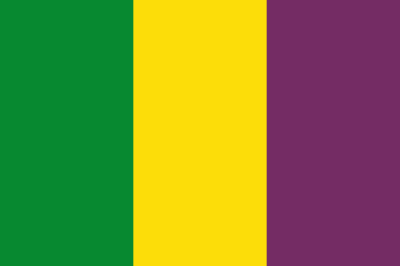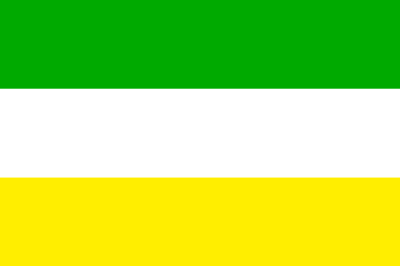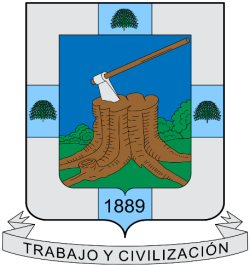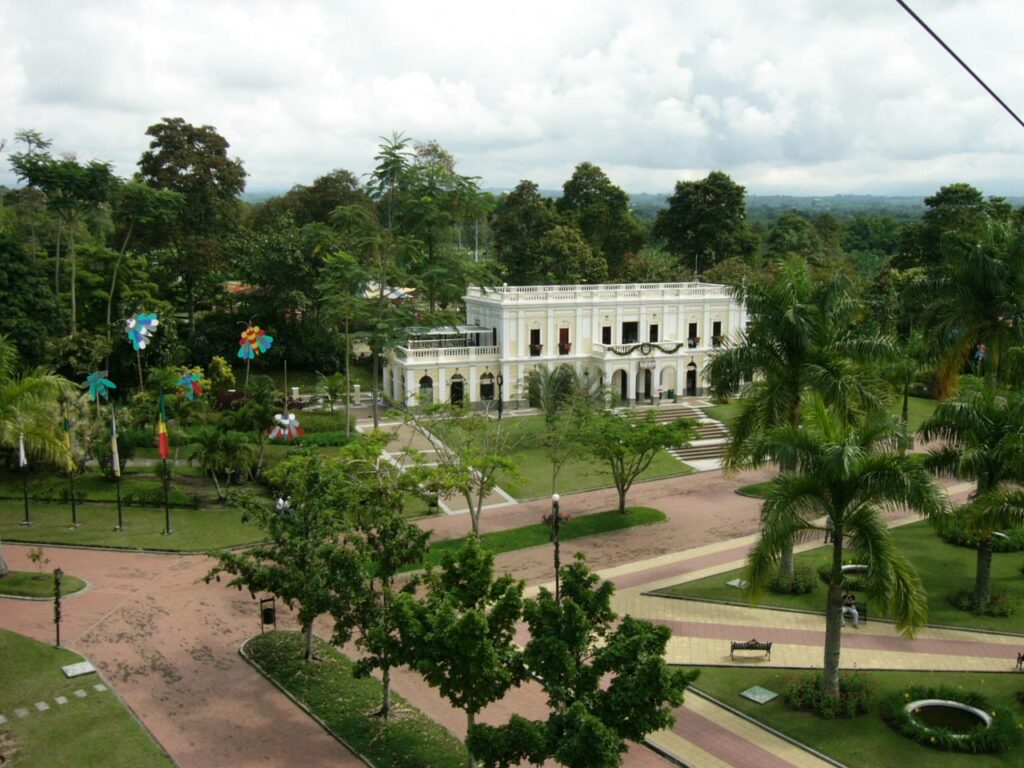Armenia
Department
Quindío, Colombia

Flag of the city
The flag of the city of Armenia is adorned with three distinct horizontal stripes. The topmost stripe is green, symbolizing the abundant vegetation and the region’s natural wealth. This vibrant hue pays homage to Armenia’s growth, fertility, and its deep-rooted agricultural heritage. The middle stripe, in pure white, portrays peace, unity, and the aspiration of the city’s inhabitants towards a harmonious coexistence. Completing the trio is a yellow stripe at the bottom, representing the city’s resources, optimism, and the bright spirit of its people. Together, these colours encapsulate the essence, values, and pride of Armenia and its citizens.

Seal of the city

Slogan of the city
Armenia, a vibrant city in Colombia, is often dubbed “The Miracle City” (La Ciudad Milagro). This moniker was inspired by its remarkable growth and transformation during the 20th century. For the latest updates and insights on Armenia, always consider checking with local sources.
History

The city of Armenia was established on October 14, 1889, by Jesús María Ocampo, commonly known as “Tigrero” or “tiger killer” because of his penchant for hunting jaguars, locally referred to as tigers. Ocampo, originally from Anaime, Tolima, sought refuge in the Quindío Mountains while escaping General Gallo. He purchased land from Antonio Herrera using one hundred gold pesos to set up a trade center, or fonda, which served not just him but also settlers from Salento, Antioquia, Manizales, and regions around the Quindío and La Vieja Rivers. Ocampo subsequently began selling plots for settlement. Wishing to bolster the young town, Ocampo revisited Anaime to recruit his friend Juan de la Cruz Cardona and to wed the young Arsenia Cardona. By August 1890, just six months post-establishment, Armenia’s population had grown to 100, granting it official recognition by the state. During the city’s foundational meeting in 1889, the name “Villa Holguín” was proposed to honor then-President Carlos Holguín Mallarino. However, it was declined in favor of “Armenia”, which was officially chosen on November 30, 1889. The popular notion that the city was named in tribute to the Armenian genocide is a misconception, as the event transpired after the city’s naming. Another theory suggests that the city might have been named after the ancient Kingdom of Armenia, although some believe it could be a tribute to the Hamidian Massacres of the 1890s. In the context of naming new settlements, many colonists often turned to biblical references.
In its early days, Armenia’s flourishing economy faced transport challenges, primarily relying on mules for transportation given the city’s mountainous surroundings. Transport took a turn for the better with the introduction of the city’s first asphalt road in 1927, connecting Armenia to Zarzal in Valle del Cauca.
Today, Armenia beautifully melds modern growth with its ancestral legacy. Notably, it’s home to the historic Liberator Pathway, a trail once used by Simon Bolívar, the iconic liberator of Colombia, during his independence movement against Spain. This path is now among the top tourist attractions in Colombia. Additionally, due to its name, many Armenian visitors are drawn to the city.
Disaster struck on January 25, 1999, when a 6.2 ML earthquake shook Quindío with Armenia at its epicentre. This earthquake is among the most tragic events in Colombia’s recent history, causing approximately 1,900 deaths. Though felt across several regions, Armenia endured the most damage. Within a mere 15 years, Armenia rose from the rubble and transformed into one of Colombia’s premier tourist destinations.
Geography of the city
Armenia, positioned approximately 290 kilometres west of Bogotá, stands at an altitude of 1,483 meters above sea level. The city can be precisely located using its geographical coordinates: 4.3270° N latitude and 75.4120° W longitude. Spanning an area of 121 km^2 (47 sq mi), Armenia is bordered to the north by Circasia and Salento, to the west by Montenegro, to the east by Calarcá, and to the south by La Tebaida. Strategically nestled near the heart of the Cordillera, it’s roughly 35 km (22 mi) from the mountain range’s summit. The city’s climate is diverse, with average temperatures fluctuating between 16–23 °C (61–73 °F).
Armenia, colloquially known as “Ciudad Milagro” or “Miracle City,” owes this title to its rapid urbanization and progression. The heart of the city boasts a nine-block pedestrian pathway, brimming with stores and eateries, linking two central plazas. While coffee, plantains, and bananas remain staple commodities in the local economy, the region to the city’s south offers a diverse climate. This is conducive not only to Quindío’s farming sector but also to a blossoming tourism industry. This comprises vacation villas, amusement parks, eco-resorts, and recreational centers, alongside the ever-popular eateries, exhibit halls, and specialized sports clubs. Many age-old plantations are still operational around the city, with several providing bed and breakfast facilities and “ecotourism” experiences. Armenia also benefits from the El Edén International Airport, which ensures frequent connectivity to cities like Bogotá, Cartagena de Indias, Medellín, Panama City, and Fort Lauderdale. This connectivity positions Armenia as a preferred location for various gatherings, spanning from conferences and conventions to social events.

Population
421,000 (2023)
417,000 (2022)
The metro area population of Armenia has seen steady growth over recent years. In 2020, the population stood at 410,000, marking a 0.74% increase from 2019. The following year, in 2021, the number rose to 414,000, reflecting a 0.98% growth. By 2022, the population further increased to 417,000, showing a 0.72% uptick from the previous year. As of 2023, the metro area’s population has reached 421,000, which is a 0.96% rise from 2022.
One photo representative of the city
Parque del Café, located in the Quindío department of Colombia, lies about 4 km southwest of Montenegro and 11 km west of Armenia, the departmental capital. The park’s inception is credited to the collaboration between the National Federation of Coffee Growers of Colombia and the Departmental Committee of Coffee Growers of Quindío, officially opening its doors on 24 February 1995. The park features two primary sections: an informative zone near the entrance that showcases the historical and cultural facets of coffee cultivation and production in the region, and a further valley area that houses an amusement park complete with various rides and entertainment.
Apart from thrilling rides, visitors can engage with animatronics shows, explore a diverse coffee garden, indulge in coffee-themed food stalls, and admire traditional Colombian architectural structures. The park’s popularity skyrocketed as it welcomed its five millionth guest in 2009 and continued to attract over a million visitors in 2017 alone.
The concept of a coffee-themed museum emerged after Diego Arango Mora, alongside his wife Margarita, visited the Sugar Museum in the nearby Valle del Cauca Department. Margarita noted that if sugar could have a dedicated museum, coffee, Colombia’s most renowned export, deserved one too. Diego, associated with the Departmental Committee of Coffee Growers of Quindío, resonated with the idea and pitched it to Jorge Cárdenas Gutiérrez, the leader of the National Federation of Coffee Growers of Colombia. Diego’s efforts to actualize the museum faced multiple challenges, including financial constraints, competing location preferences, and skepticism about Montenegro being the museum’s chosen location.
Despite these hurdles, the museum opened in 1995 and welcomed 250,000 visitors within its inaugural year. Yet, feedback indicated that the older generation primarily appreciated the park, while the younger audience remained hesitant to revisit. In response, Diego introduced an amusement section, integrating attractions like the gondola lift, steam railway, roller coaster, and other engaging rides to cater to a wider age group.

Etymology
The city was founded on October 14, 1889, by Jesús María Ocampo, also known as “Tigrero” (translates to “tiger killer”) due to his love of hunting jaguars, known locally as tigers. Ocampo came from Anaime, Tolima, looking for shelter in the mountains of Quindío because he was running away from General Gallo.
During the initial city naming meeting on October 14, 1889, the name “Villa Holguín” was proposed in tribute to the sitting president, Carlos Holguín Mallarino. This suggestion, however, was turned down. Instead, on November 30, 1889, the name “Armenia” was chosen through a vote. Contrary to some beliefs, this name wasn’t selected in remembrance of the Armenians persecuted by the Ottoman Turks during the Hamidian massacres or the Armenian genocide, since these events took place years after the city’s naming. While some argue that the name might have been influenced by the historical Kingdom of Armenia, there are persistent rumours about it being an homage to the massacres in the 1890s. Another plausible theory suggests settlers may have used biblical references when naming their new locations.
What the city is known or famous for
Armenia, nestled in the heart of Colombia’s iconic “Coffee Triangle,” is a beacon of the nation’s rich coffee heritage and tradition. This city, along with its surrounding regions, has fertile soils and a perfect climate that create ideal conditions for cultivating the Arabica coffee bean, known globally for its exceptional quality and distinct flavour profile. The verdant hillsides surrounding Armenia are adorned with meticulously arranged coffee plantations, where the beans are grown, harvested, and processed, often following time-honoured methods passed down through generations.
But beyond just production, coffee has deeply influenced the cultural fabric of Armenia. For many local families, coffee cultivation isn’t just a livelihood; it’s a way of life. Stories of ancestors establishing the first coffee farms, tales of seasons gone by, and the anticipation of the next harvest season are commonly shared among the community. This reverence for coffee is evident in the daily life of Armenia’s residents, from the meticulous care farmers give to their crops to the aromatic coffee shops and cafes that dot the city streets. The rituals of coffee preparation and consumption are cherished, transforming a simple beverage into a symbol of community, history, and pride. Armenia’s identity is, in many ways, intertwined with its role as a guardian of Colombia’s celebrated coffee culture.
